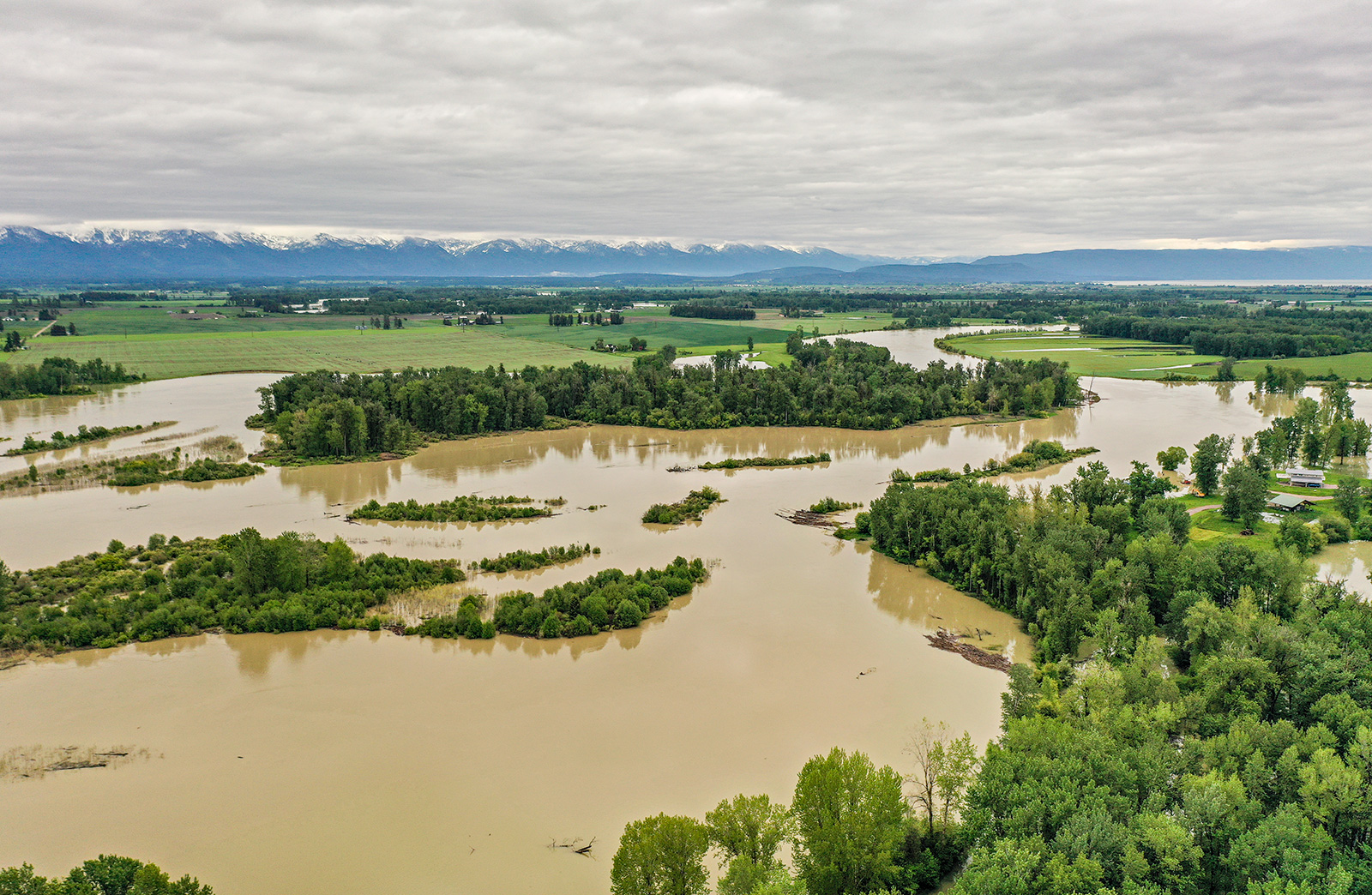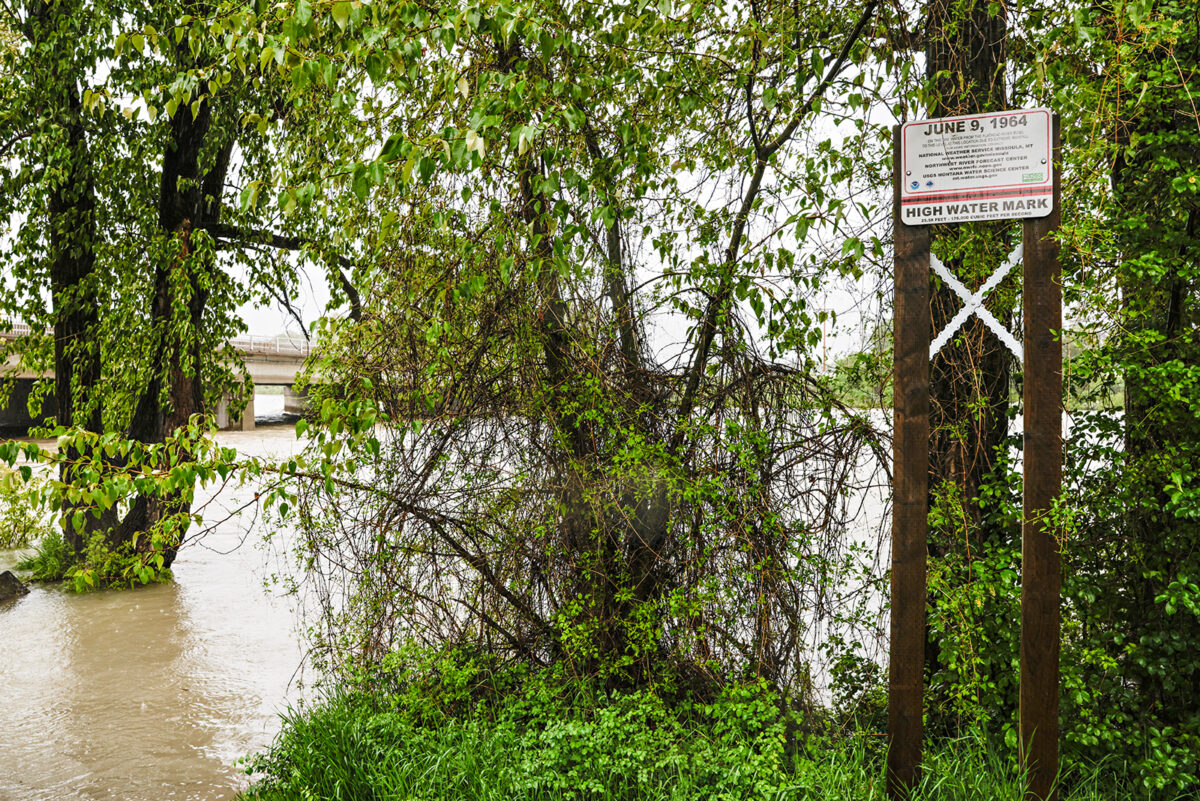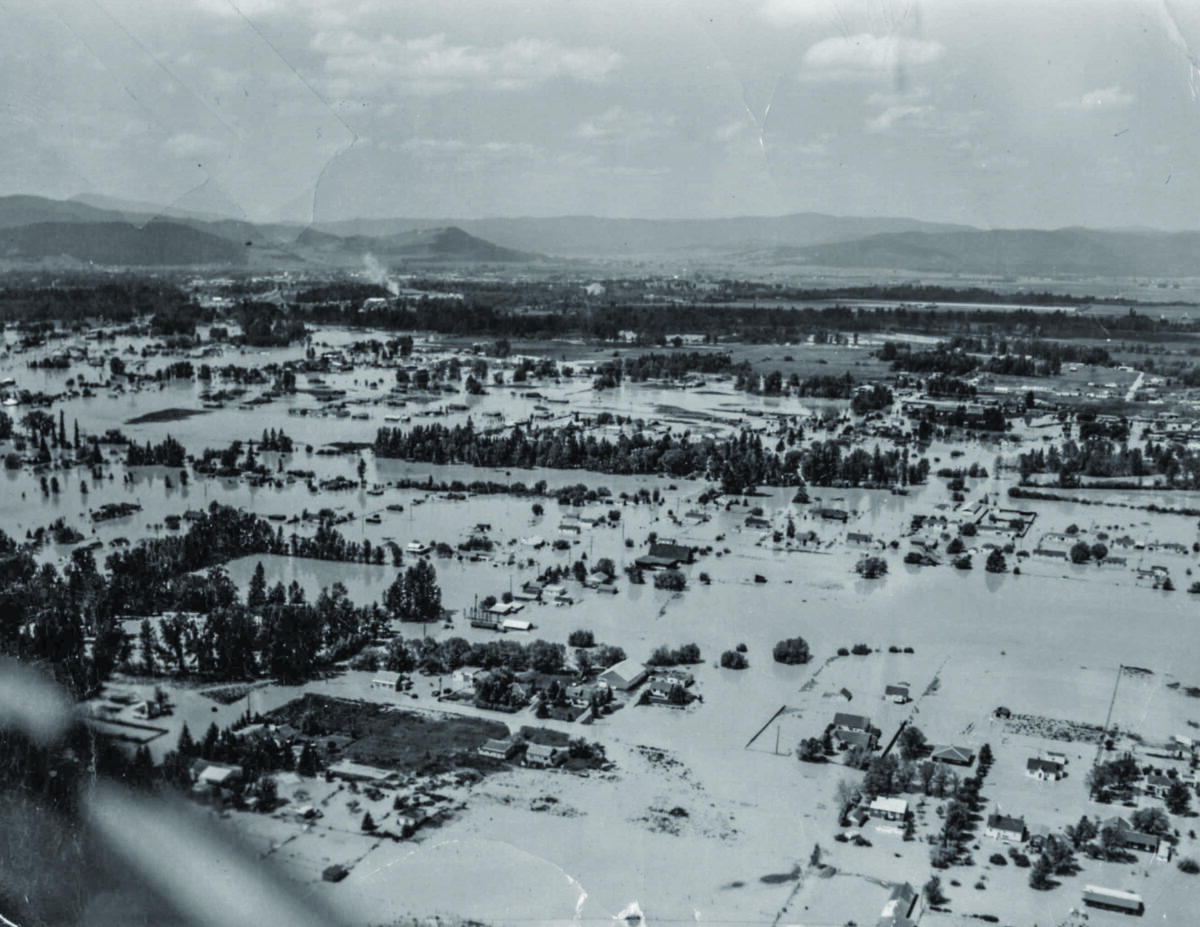Flathead Flood Preparedness Project Presses On, Despite $75,000 Funding Cut
The nonprofit Climate Smart Glacier Country is piecing together a plan to improve local flood readiness and offset the increasing cost of insurance for homeowners — even after the Trump Administration terminated its primary funding source
By Tristan Scott
In June 1964, the most severe floods in northwest Montana’s history devastated rural communities spanning the Continental Divide, killing dozens of people, injuring hundreds and displacing thousands as recovery efforts stretched on for months. The toll of the 500-year flood’s destruction would be magnitudes greater today, while the conditions that triggered the raging waters —warm temperatures and heavy rain causing rapid mountain snowmelt — are more common than ever before.
More than a half century after the 1964 disaster, the modern framework for emergency flood preparedness in the Flathead Valley and across Montana is developed with a 100-year flood scenario in mind, shaping planning and zoning regulations, building codes, early-warning systems, evacuation procedures, and flood insurance rates.
But what would happen in the event of another 1964-scale flood? How many people would it affect, and what sort of plan is in place to guide an emergency response of that scale?
As the intensity and frequency of natural disasters like floods accelerate amid rising global temperatures, it’s a question that organizers with Climate Smart Glacier Country posed earlier this year when they approached community stakeholders, as well as city, county and state government officials, about adopting new strategies to improve flood readiness, particularly in communities that have grown up in or expanded to the 500-year floodplain in the past 50 years.
“Everyone seems to understand that it’s not a question of if it’s going to happen, but when it’s going to happen. And climate change is turbocharging the risk,” said Steve Thompson, the board chair of Climate Smart Glacier Country, a local nonprofit that works toward community-based climate solutions and adaptations. “We don’t even have to call it climate change. The oceans are warmer, the air is warmer, you combine those two things and, call it what you want, but it’s a supersized risk.”
To galvanize a community-based effort to mitigate local flood risk, Climate Smart Glacier Country applied for and received a $75,000 grant through the U.S. Environmental Protection Agency’s (EPA) Thriving Communities Grantmaking program. Part of a broader congressional mandate under the Inflation Reduction Act, the block grants were awarded to address environmental justice issues that take a disproportionately heavy toll on communities of low-income and rural areas.
When he began gauging the interest of local communities who stood to benefit from the project, Thompson said the response was overwhelmingly supportive.

“There’s value and utility in having the conversation, but when we started meeting with potential partners we realized there’s a lot of interest in this as a community exercise that could have tangible benefits,” Thompson said, explaining that his flood preparedness project would increase awareness of property owners and infrastructure managers who could be directly affected.
But since President Donald Trump returned to office, his administration has targeted federal support for initiatives seeking to address those disproportionate impacts. In May, Thompson received a termination letter notifying him that Climate Smart Glacier Country’s grant had been canceled.
Given newly appointed EPA Administrator Lee Zeldin’s characterization of environmental justice grants as “an excuse to fund left-wing activists,” the news didn’t come as a surprise to Thompson, even as he enlisted a broad range of support for his flood-readiness project from Whitefish, Columbia Falls, Kalispell, and Flathead County.
Cyrus Western, the new EPA Region 8 administrator, said the grantmaking program was among a raft of initiatives vetted by the agency and terminated because the spending didn’t align with administrative priorities. But he also urged local stakeholders not to interpret the grant’s termination as an indictment of community-based efforts to assess flood risk, particularly if they improve their respective Community Rating System (CRS) score, which the Federal Emergency Management Agency (FEMA) uses to determine insurance rates through the National Flood Insurance Program.
“Flood insurance is expensive,” Western said last month during a visit to the Flathead. “Just because we’re saying no to the funding right now doesn’t mean it’s a bad idea.”
Without the EPA funding, however, the project is limping along as smaller grants from the Whitefish Community Foundation and the Western Montana Conservation Commission provide crutch assistance. Even so, Thompson is determined to continue.
“We had an overall budget of $110,000 and we lost $75,000. And we were using that to leverage other funding sources,” Thompson said. “We’ve reduced the scope of the project so that it’s more modular now. But we’re cobbling it together.”

For Jeff Mow, a former superintendent of Glacier National Park and the vice chair of Climate Smart Glacier Country, engaging Flathead residents in scenario planning, flood awareness and mitigation strategies is a no-brainer. Having helped the National Park Service develop tabletop scenarios to plan for climate change adaptations, including flood and wildfire emergencies, he teamed up with Thompson earlier this year to help get the project off the ground.
Dubbed “Anticipating the Flood Next Time: Building Community Resilience for a 1964-Scale Scenario,” the public-private partnership seemed timely after the 500-year Yellowstone River floods in 2022 — a season that also brought flooding to the Flathead Valley — as well as the recent floods in North Carolina, Kentucky, Vermont, and last month’s destructive and deadly flooding in the Hill Country region of Texas.
The common denominator linking all those events, other than floodwater, is that local communities did not anticipate them, Mow said.
“The trauma of these events is not just physical but it’s also psychological,” Mow said. “The effect of having something hit you upside the head and upend your life when it was so far outside the realm of possibility, that scars people, even if it doesn’t impact them. There’s value just in having the conversation.”
According to the 2025 Western Montana Hazard Mitigation Plan (WMHMP) recently adopted by state and local agencies, 11,481 Flathead County residents live within the historical 100-year floodplain, or about 10% of the population. The estimated loss due to a 100-year flood, which assigns a 1% annual chance of such a flood occurring, is $383 million. The WMHMP pegs the total value at risk in the floodplain at $1.5 billion, including 136 critical facilities, ranging from energy and communications to healthcare and public safety. Flathead County has the highest expected annual loss rating in the western region, according to the WMHMP, as well as the highest amount of critical facilities — 108 transportation lifelines, 12 communication facilities, six energy facilities, five food, water and shelter facilities, and five safety and secure facilities.
The WMHMP does not assess the potential impacts of a larger 1964-scale megaflood, which would impact a broader segment of the county, with lower-income communities along the main stem of the Flathead river — especially unincorporated areas, including Evergreen and parts of Kalispell — experiencing the brunt of the destruction.
“Pretty much all of Evergreen would be in the 500-year floodplain,” Erik Mack, Flathead County’s planning and zoning director, said. “We don’t regulate for the 500-year floodplain; our permitting kicks in for the 100-year floodplain. But that doesn’t mean we shouldn’t make people aware of the risk of living and developing in the 500-year floodplain and help them prepare for an emergency.”

Flathead County would almost certainly benefit from the flood-readiness project’s initiative to reduce insurance premiums by improving its score under FEMA’s Community Rating System, Mack said. The Flathead is among 11 communities in Montana that currently participate in the National Flood Insurance Program and CRS program.
That program incentivizes communities that go above and beyond FEMA’s minimum flood mitigation requirements, awarding discounts based on their CRS class. Criteria for improving a county’s CRS rating fall under four categories — public information; mapping and regulations; flood damage reduction; and warning and response.
For years, Flathead County’s CRS class had been an 8, which awards a 10% discount; however, it was downgraded to a 9, which awards a 5% discount, after the county failed to update its hazard mitigation plan. Adopted in 2009 and required to undergo revisions every five years, Flathead County’s plan expired in 2019 and still hadn’t been updated when the state shifted to a regional hazard mitigation plan in 2022, in large part because it recognized that numerous counties were struggling to finance the updates on their own. In 2014, the last time Flathead County hired a contractor to update its plan, it cost $40,000.

“When you have as many rural counties as Montana does, that’s a lot of money to update your plan every five years,” Juanita Nelson, director of Flathead County’s Office of Emergency Services, said. “So the state broke us up into different regions and agreed to pay the contracts.”
By the time Flathead County submitted its annex plan for inclusion in the regional WMHMP, it was eight years out of date, Mack said.
“We did our update in November 2022, but it had been eight years since the last time the plan was updated, and that impacted our CRS rating,” Mack said.
When Thompson and Mow approached the county about participating in the flood-readiness project, Mack said he saw an opportunity to overhaul the county’s floodplain regulations and update its topographic maps for the first time since 2015, as well as improve their accuracy using LIDAR technology.
“Having the latest maps available and updating our floodplain regulations would have helped, and so would the public outreach,” Mack said of the project’s potential benefits. “It would be nice to get back to an 8 on the CRS program, and maybe even higher. So if there are organizations out there willing to do much of that work and secure grant funding for us, we would be happy to provide input and participate. Anything we can to do help with insurance costs, I would be very happy to do it.”

Beyond lowering insurance premiums, Nelson knows firsthand how flood readiness can help in an emergency, particularly when communities have advance notice. That’s why modeling tabletop exercises after worst-case scenarios can be valuable in the event of even minor floods. For instance, in June 2022 the Flathead Valley experienced a degree of flooding it had not encountered since 1975. Although it paled in comparison to the devastation at Yellowstone National Park and its gateway towns, where record floods pounded bridges and roadways and recovery efforts stretched for months, Nelson said the Flathead Valley didn’t know to brace for such an event.
“The flood of 2022 caught us off guard because we weren’t experiencing an atmospheric river,” Nelson said. “I was able to contact the Army Corps of Engineers and they brought in a sandbag machine to help us fill bags. We coordinated with the Bureau of Reclamation and asked them not to increase the CFS at Hungry Horse and SKQ Dams. It’s all about resource allocation and knowing when to bring all hands on deck, and by modeling for worst-case scenarios we can bring all of our partners to the table and say, ‘this is our plan.’”
In Montana, the Department of Natural Resources and Conservation (DNRC) is the agency that provides support to local communities in the administration of their floodplain programs, including education, outreach, coordination, technical assistance, tools, and resources. Last spring, Climate Smart Glacier Country invited DNRC officials to give presentation to floodplain administrators in Flathead County. The aim of the presentation was to touch on a range of steps that local governments can take to improve Flathead County’s FEMA CRS score to further reduce flood insurance rates and improve flood preparation.
Nelson said it was a step in the right direction, and she hopes the project’s efforts to educate the public about the consequences of a 1964-scale flood can continue.
“In the past 50 years we have built a lot of homes in areas that were underwater in 1964,” Nelson said. “So, anything we can do to plan for a worst-case scenario is going to be beneficial to our response in the event of an emergency such as a flood. How many people do we need to evacuate? Where are we going to relocate them? What kinds of road closures? How many sandbags? Being proactive can go a long way toward mitigating the consequences later.”